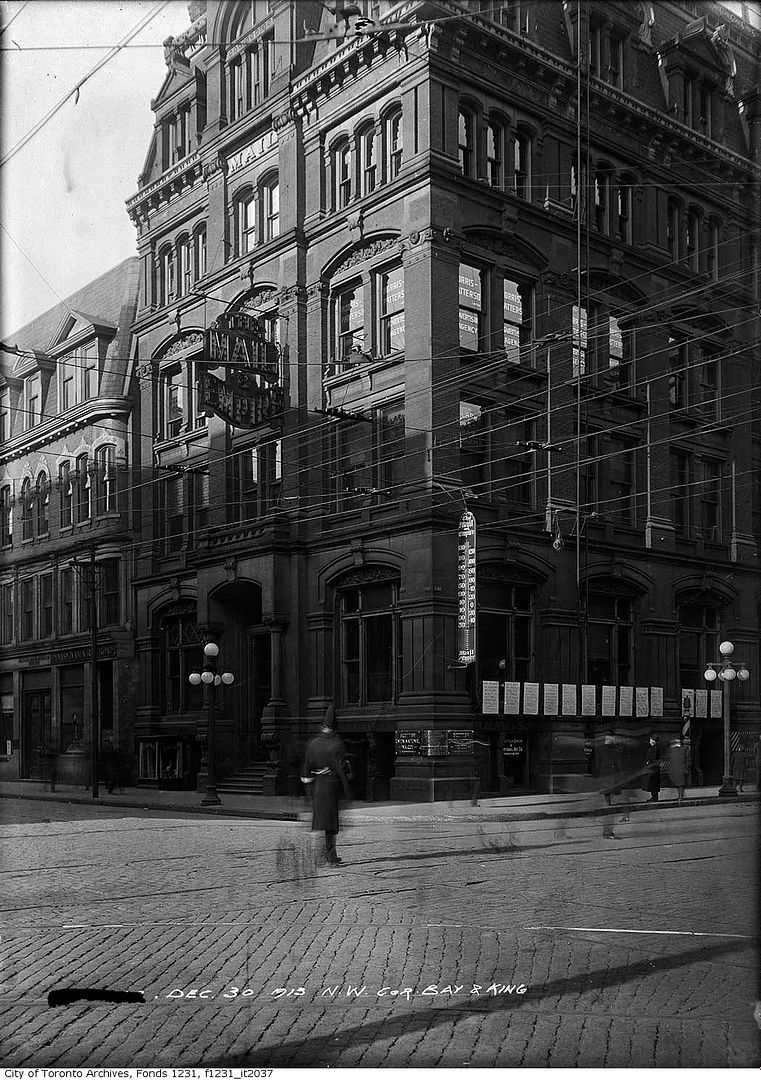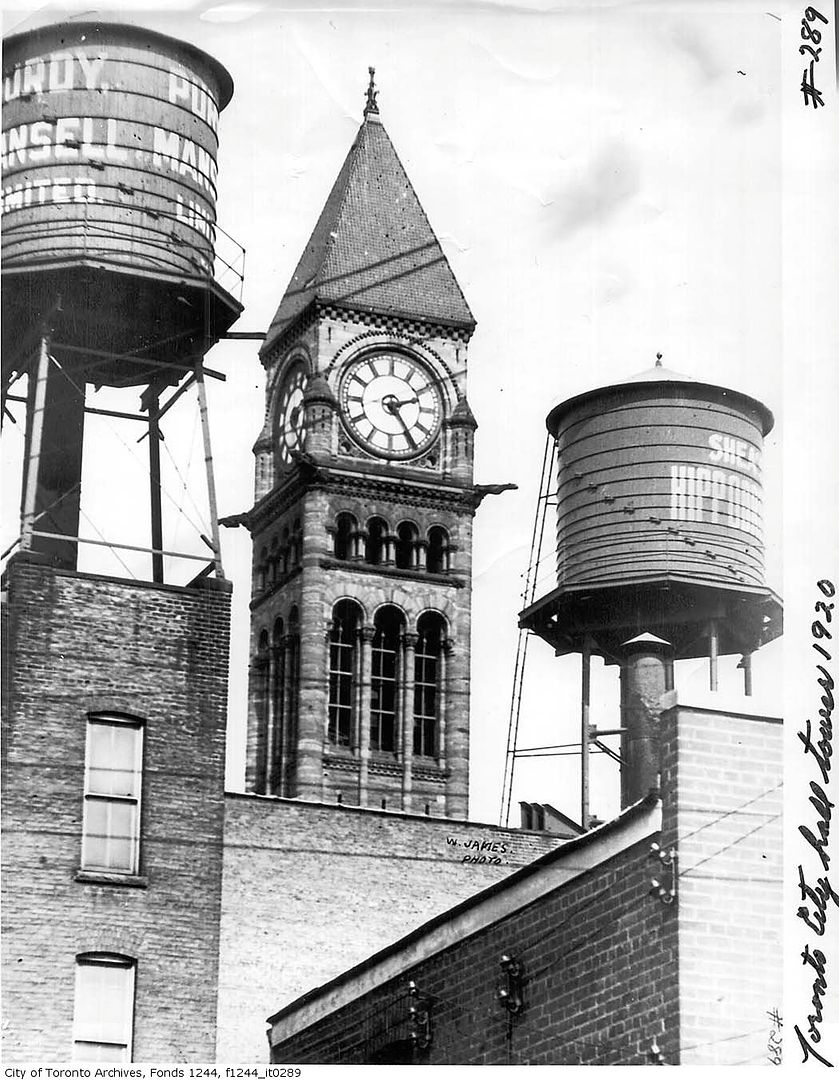Mustapha
Senior Member
Myself, I'd be interested in tracing the earlier instances of digital time/info display in town, like here. (I remember someone saying that Manning Chambers across from Old City Hall--and demolished for New City Hall--also sported a noteworthy display late in its lifetime. Wonder if there are pictures of *that*...)
Some thoughts on public clocks:
"By WILLIAM M. BULKELEY
Staff Reporter of THE WALL STREET JOURNAL
Their time has come, again.
Not so long ago, public clocks appeared doomed in the U.S. Inexorably, they faded from view, replaced with faceless digital readouts on modern facades — or with nothing at all. The watchless were left to their own devices.
People like Peter Sonnabend, vice chairman of the Sonesta Hotels chain: “I’m one of the great unwatched,” he says. “I have to rely on the kindness of strangers and public clocks.” Or Boston preservationist Jane Holtz Kay, who laments the disappearance of clocks in her Back Bay neighborhood. Public clocks, she says, are a kind of “street furniture.
But public timepieces — the predigital, often whimsical variety — are making a comeback. In places like Battle Creek, Mich., where Kellogg Co. has commissioned a large musical clock featuring Tony the Tiger and Snap, Crackle and Pop of Rice Krispies fame. When the clock strikes the hour, the characters dive into a large bowl of sculpted milk.
On New York’s Madison Avenue, where watch-dealer Tourneau Inc. just installed a time machine, 11 feet in diameter, with a moon-phase predictor and 27 different clock faces that indicate the time in cities around the globe.
Even at a Las Vegas casino, the Santa Fe, which recently broke with gambling’s timeworn anticlock tradition (based on a sense that clocks, and windows for that matter, might distract from the slot machines at hand) and hung an elaborate four-face, verdigris Edwardian reproduction over the bar.
In the 1960s, the most common new clocks were spare, digital time-and-temperature illuminations on banks. But today, “digital is dead,” says Thomas Erb, president and owner of Electric Time Co., of Medfield, Mass., which built the $900,000 Tourneau timepiece and claims to be the nation’s biggest maker of public clocks. “You can get a $7 watch that’s more accurate,” says Mr. Erb, “but street clocks have become very popular.” He says business has doubled in the past five years.
Why the about-face? “People are trying to get back a sense of community and a town center, and clock towers do that,” says Lisa Reindorf, a Boston architect who designed a new clock tower to renovate an aging Rhode Island strip mall.
Then there is the renewed interest among city planners and architects in smaller-scale pedestrian areas, where analog clocks fit in neatly. In time, commercial architects and landlords hope, a clock will transform their buildings from storefronts to landmarks. For a new shopping center, Hulbert Group International, a West Vancouver, B.C., firm, had Electric Time create a clock that shows phases of the moon and wind speed as well as the time. “The intention was to get people to say, ‘I’ll meet you at the clock,’ ” says Steve Best, project architect.
The once-popular digital displays proved costly to power — as much as $1,000 a year. And “they’re cold and impersonal. They don’t have any style to them,” complains Thomas Bartels, executive director of the National Association of Watch and Clock Collectors in Columbia, Pa., whose membership has grown 17% to 35,000 in the past five years.
Time in a Vacuum
Analog clock aficionados argue, moreover, that digital readouts leave time in a vacuum. “With a traditional clock, the time is recognizable at a glance. You get a sense of time forward and back without doing subtraction,” says John DeFazio, a Hightstown, N.J., architect who designed the Tourneau clock installation.
The coming millennium is also fueling interest in public time displays.
Back then, public clocks were functional, as well as attractive. Mill owners bought clocks with bells that would tell workers when to return from breaks and when to quit for the day. Watches were the privilege of the middle class, and most workers didn’t own timepieces.
During the 18th and 19th centuries, tower clocks became a major civic investment both here and abroad. Seth Thomas Co., namesake of Thomaston, Conn., and E. Howard Co. of Boston, employed hundreds of clockmakers assembling gears, weights, escapements, clock faces and movements for tower clocks. The public-clock business later dwindled as cheaper electric motors replaced the complicated works of mechanical clocks in the 1930s.
To Chime or Not to Chime
Ironically, the semiconductor chip has played a role in the revival of analog public clocks by eliminating much of the labor involved in maintaining them. Clocks now include battery-powered chips that automatically reset the clock after electrical power outages. They can be programmed to make the clock spring ahead and fall back for daylight-saving time. “You can even program them to chime any hours you wish, or not chime” when people are sleeping, says David Todd, a clock specialist at the Smithsonian Institution in Washington, who thinks the clocks are regaining popularity because “they’re an anchor to a slightly more benevolent world.”
Real clock fans would like to turn back the hands of time to fully mechanical clocks. Linda Balzer heads the clock-restoration operations of Balzer Clock Co. in Freeport, Maine, which has been restoring as many as 10 tower clocks a year and recently restored a 22-foot-diameter clock at the Ayer Mill in Lawrence, Mass., for $110,000. She says: “When you replace a mechanical clock with an electric one, you’re not putting in a better system. Properly maintained, a mechanical clock will last 500 years.” (The world’s oldest working clock, in Salisbury Cathedral in England, is more than 600 years old.)
Mr. Erb of Electric Time admires Balzer’s work, but for towns that don’t have restorable antiques, he creates “elegant” reproductions. One of them, designed for street corners, sits atop a tall, fluted column. A replica of a Seth Thomas design, it features an intricate, cubical clock case with four faces and miniature lion heads set at each corner. Unlike the original cast-iron designs, Electric Time’s posts and cases are made of aluminum, which is less likely to rust or crack.
Such reproductions attract people like Edna McCall, a flag-store owner in Crystal Lake, Ill., outside Chicago, who headed a town committee administering a fund left by a resident to do “something for the town.” The committee spent several million dollars buying and refurbishing an old theater as an arts center.
Then it spent some remaining funds on a $30,000, 20-foot-high post clock from Electric Time. “Not everyone will benefit from the theater,” she says, “but all the people will benefit from the clock.”
http://www.electrictime.com/news/po...say-about-Old-Style-Public-Street-Clocks.aspx














